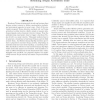Free Online Productivity Tools
i2Speak
i2Symbol
i2OCR
iTex2Img
iWeb2Print
iWeb2Shot
i2Type
iPdf2Split
iPdf2Merge
i2Bopomofo
i2Arabic
i2Style
i2Image
i2PDF
iLatex2Rtf
Sci2ools
HOST
2009
IEEE
2009
IEEE
New Design Strategy for Improving Hardware Trojan Detection and Reducing Trojan Activation Time
Hardware Trojans in integrated circuits and systems have become serious concern to fabless semiconductor industry and government agencies in recent years. Most of the previously proposed Trojan detection methods rely on Trojan activation to either observe a faulty output or measure sidechannel signals such as transient current or charge. From the authentication stand point, time to trigger a hardware Trojan circuit is a a major concern. This paper analyzes time to (i) generate a transition in functional Trojans and (ii) fully activate them. An efficient dummy flip-flop insertion procedure is proposed to increase Trojan activity. Depending on authentication time and circuit topology, a transition probability threshold is selected so that inserted dummy flip-flops would moderately impact area overhead. The simulation results on s38417 benchmark circuit demonstrate that, with a negligible area overhead, our proposed method can significantly increase Trojan activity and reduce Trojan acti...
| Added | 19 Aug 2010 |
| Updated | 19 Aug 2010 |
| Type | Conference |
| Year | 2009 |
| Where | HOST |
| Authors | Hassan Salmani, Mohammad Tehranipoor, Jim Plusquellic |
Comments (0)

